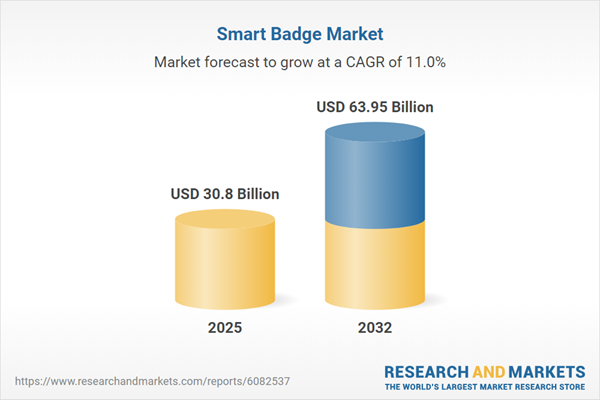Speak directly to the analyst to clarify any post sales queries you may have.
The smart badge market is strategically advancing as organizations seek robust, interconnected identity solutions to secure facilities, manage workflows, and gain real-time operational intelligence. Senior leaders are prioritizing digitalization efforts that enable adaptive security and workforce visibility across diverse enterprise environments.
Smart Badge Market Snapshot
The global smart badge market is showing notable growth, moving from USD 27.68 billion in 2024 to USD 30.80 billion in 2025, and is forecasted to reach USD 63.95 billion by 2032 with a compound annual growth rate (CAGR) of 11.03%. This expansion signals a rising preference for integrated identification and workflow automation, as organizations adapt to stringent safety requirements and ongoing digital modernization. Smart badge adoption is directly linked to increasing demand for scalable authentication and transparent, real-time tracking in operational settings.
Scope & Segmentation of the Smart Badge Market
- Industry Verticals: Adoption spans education, healthcare, manufacturing, retail, and transportation and logistics, supporting secure access and workforce management in both public and private sectors.
- Communication Technologies: Deployment leverages Bluetooth variants for wireless interaction, NFC for short-range secure data exchange, RFID—with both active and passive modes—for asset visibility, WiFi for broader connectivity, and ZigBee for device mesh networking in complex sites.
- Product Types: Solutions include active badges using infrared and radio frequency for continuous tracking, energy harvesting badges using movement or solar for power resilience, and passive tags ideal for high-traffic deployment at lower cost.
- Distribution Channels: Enterprises access badges through direct sales, distributor networks, online portals, and OEM partnerships, ensuring procurement flexibility and market reach.
- Deployment Modes: Options include cloud environments (public, private, hybrid) and on-premises setups (with managed or self-hosted services), enabling alignment with company security and compliance needs.
- Price Ranges: Vendors address a range of budgets, offering solutions from entry-level to high-end, supporting scalability and tailored investments for various organizational sizes.
- Geographies: Market growth is evident across the Americas, Europe, Middle East and Africa, and Asia-Pacific, with pronounced activity in major economies such as China, India, Japan, Australia, and South Korea.
- Leading Companies: Noteworthy providers include ASSA ABLOY AB, Zebra Technologies Corporation, Honeywell International Inc., NXP Semiconductors N.V., STMicroelectronics N.V., Avery Dennison Corporation, Impinj, Inc., Identiv, Inc., Invengo Information Technology Co., Ltd, and Thin Film Electronics ASA, underlining ongoing innovation and competition.
Key Takeaways for Smart Badge Market Stakeholders
- Smart badges provide organizations with enhanced personnel and asset monitoring capabilities, facilitating more effective oversight in manufacturing, healthcare, and logistics.
- Edge computing, Internet of Things (IoT), and cloud integration deliver real-time business intelligence, supporting adaptive applications and improved decision-making with actionable data.
- Device security—ensured through embedded encryption and robust authentication—addresses compliance demands while reducing cybersecurity vulnerabilities in connected environments.
- Regional sourcing and a focus on domestic production contribute to supply chain resilience and flexibility, particularly as businesses navigate regulatory and geopolitical complexities.
- Flexible deployment and modular smart badge product designs enable organizations to future-proof their IT infrastructure and control investment costs, making solutions accessible to both large enterprises and mid-sized firms.
- Global standardization and cross-border technology partnerships simplify integration, helping enterprises overcome adoption barriers and streamline regulatory compliance.
Tariff Impact on Supply and Cost Structures
Recent tariff adjustments in the United States have raised the acquisition costs for essential smart badge components. As a result, manufacturers are emphasizing domestic sourcing, expanding supplier diversification, and evaluating alternative materials to address inflation and safeguard competitiveness. These shifts are impacting pricing models and driving intensified competition in the sector.
Methodology & Data Sources
Insights are derived from direct interviews with technology suppliers and systems integrators, as well as surveys conducted among facility managers and IT decision-makers. Secondary research includes analysis of trade journals, industry associations, peer-reviewed studies, and public company filings to ensure reliable market validation.
Why This Report Matters
- Supports executives with benchmarking, supplier optimization, and regional planning strategies for smart badge deployment and secure access management.
- Prepares stakeholders to adapt to changes in regulation, costs, and technology, enabling agile risk management and long-term business sustainability.
- Delivers segmentation insights and price analysis, informing targeted product development and focused go-to-market initiatives.
Conclusion
As digital transformation accelerates, smart badge solutions are essential for enterprise operational efficiency and risk mitigation. Organizations investing in flexible, secure, and interoperable systems are well-positioned to excel in evolving industry landscapes.
Table of Contents
3. Executive Summary
4. Market Overview
7. Cumulative Impact of Artificial Intelligence 2025
Companies Mentioned
The companies profiled in this Smart Badge market report include:- ASSA ABLOY AB
- Zebra Technologies Corporation
- Honeywell International Inc.
- NXP Semiconductors N.V.
- STMicroelectronics N.V.
- Avery Dennison Corporation
- Impinj, Inc.
- Identiv, Inc.
- Invengo Information Technology Co., Ltd
- Thin Film Electronics ASA
Table Information
| Report Attribute | Details |
|---|---|
| No. of Pages | 183 |
| Published | November 2025 |
| Forecast Period | 2025 - 2032 |
| Estimated Market Value ( USD | $ 30.8 Billion |
| Forecasted Market Value ( USD | $ 63.95 Billion |
| Compound Annual Growth Rate | 11.0% |
| Regions Covered | Global |
| No. of Companies Mentioned | 11 |









